Surf Ski First Looks: Honcho Oceans Pro
 It's not often that a totally new ski from a new
manufacturer is released onto the market - but we were lucky enough to lay
hands on just such a one in the form of the Oceans Pro ski from Honcho
Surfskis.
It's not often that a totally new ski from a new
manufacturer is released onto the market - but we were lucky enough to lay
hands on just such a one in the form of the Oceans Pro ski from Honcho
Surfskis.
Here's what we found.
Andrew Fyfe - the "Head Honcho"
Andrew Fyfe has a history of fiberglass manufacture. He spent school holidays at his father's factory - and shaped and glassed (and used) his own surfboard before the age of fifteen. He says he's always had a fascination for the material.
While better known in South Africa for a premium brand of canopies for pickups, Andrew has manufactured a variety of products ranging from paddleskis to mini-caravans.
So how did he get into the surfski business? "My fiancée Jean is a sports enthusiast," he explained, "and we decided to start paddling together on a double ski." When he saw the ski he'd ordered, he was unimpressed by the build quality. "I can do better than that," he thought...
Design Team
Apart from Andrew himself, the design team included well-known Cape Town yacht designer Phil Southwell as well as paddlers Jamii Hamlin, Richard Kohler and John van der Vyver. R&D has taken some eighteen months.

The plug was built up from profiles taken from CAD drawings, with wooden planking sanded to shape, in a similar manner to building a yacht hull.
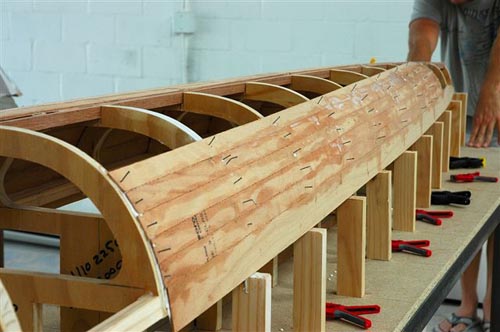
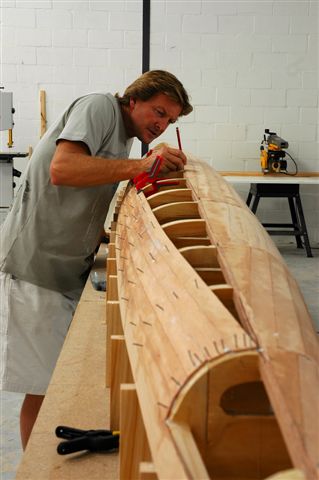
Jamii Hamlin paddled the 2006 Discovery Men's Health series in the first prototype - and also completed the grueling 244km 2006 PE to EL Challenge in the ski. Inputs from the testing were incorporated in the final design.
"First Looks"
First impressions? The build quality is exceptional. An interesting feature is the seam - which is almost invisible. Andrew uses what he calls a "biscuit tin" join where the flange is included in the hull mould. He says this is far stronger than the conventional practice of adding the flange as a separate piece.
"Return to Shore Technology"
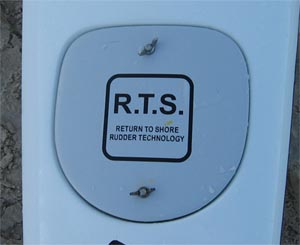
The rudder box cover is fastened by two butterfly screws. This enables the cover to be removed without a screwdriver - to reveal an innovative emergency steering solution. Whether they're manufactured from steel cable or cord, rudder cables break (and it happened twice last season in extreme conditions to guys I was paddling with).
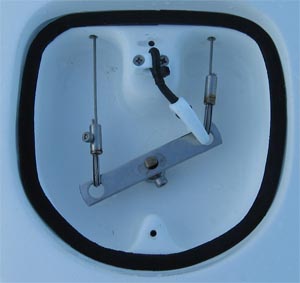
The Honcho solution comprises a short section of bungee cord that can be hooked onto one side of the tiller bar - the side that the rudder cable has broken - and hey presto! Steering is possible with one pedal.
Paddling the Honcho
We had the ski - one of the first out of the production mould - for two weekends during which we were able to try it in a variety of conditions.
My first taste of the Honcho was on a flat calm sea at Fish Hoek. Setting it up was straight forward - the rudder pedal adjusts easily with what has become a conventional mechanism - pull a cable in front of the footplate and move the entire assembly until it clicks into place at the desired spot. The rudder cable adjustment is innovative - a butterfly screw that can be tightened by hand. On the ski we had the screw impacted directly onto the cable (potentially damaging it) - but Andrew says that new skis will have a slightly more involved adjuster where a metal plate protects the cable from the screw.
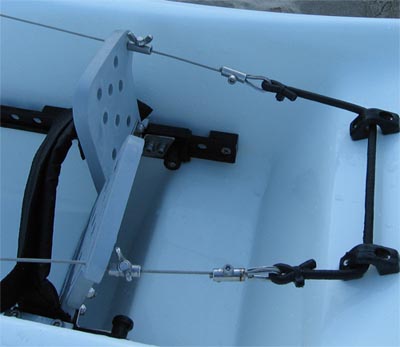
On the water the ski felt pretty good - a little tippier than the Mako6, but ok. There was some small surf breaking on the beach & I took the ski in and out a couple of times - it seemed to pop over the waves easily going out & to catch them readily on the way in.
The next day I took the ski out again from Hout Bay. We went out to Vulcan Rock and back on an oily calm sea. Although I again felt the ski to be tippy, I became more and more used to it as time went on and on the way back from Vulcan Rock to Seal Island I had fun catching the small swells that were running in the same direction. There is no doubt: this ski catches runs very easily.
Seat Position
At Seal Island I swapped skis with Alain Jaques. On climbing into his ski I felt as though I was sitting back in an armchair and I realized how comfortable the Honcho's seat position is - you feel as though your heels are well below the level of your backside and your body is left in the ideal posture for the paddle stroke.

Alain immediately took to the ski, also finding it easy to catch the small runs on offer. Al owns a Fenn Millennium and agreed that the Honcho, although tippier than the Mako6 is "nowhere near" as tippy as the Millennium.
He also highlighted a problem that would become very apparent the following weekend - the poor cockpit drainage. We were chasing a tourist boat, riding its wake, when I broached into him and caused him to fall off the ski. He remounted handily but the tumble left the cockpit full of water and it took a while for it to drain.
Speed
How fast is any ski? Hmm... sticking my neck out with this one. To be sure, comfort and familiarity play a major role with how well and how fast a particular paddler can perform in a ski. However - I'll stick my neck out and say that I think this is quite a fast ski.
The day after our first trip, my paddling buddy Dale Lippstreu and I went with a group of other paddlers out to Vulcan Rock again. Again the chop was not severe, but neither was the sea totally flat. We paddled, not at race speed, but at about 85% effort i.e. we were going hard but not all out. The GPS was registering between 11 and 12km/h. That's a fair speed for me and I was impressed with the ski.
After the paddle, Dale & I had a couple of dices on the flat water of Hout Bay harbor. Both of us were faster on his ski, a V10L Ultra - but that wasn't unexpected given that his ski is almost half the weight of the glass layup Honcho.
Stability
My balance is not legendary - and to give some perspective on this I should mention that I find some of the older top end ski designs difficult to handle in chop. On the other hand I find the Fenn Mako6 and V10 comfortable in almost any conditions. So - how does the Honcho compare?
I found the ski more tippy than the Mako6, but less so than the Fenn Millennium and in moderately choppy conditions in Hout Bay on my third paddle on the Honcho, I felt pretty comfortable.
Upwind Paddling
While paddling into chop in Hout Bay, both my companion and I noticed the relative quietness of the Honcho going upwind. Perhaps it's to do with the rocker on the hull, but it definitely wasn't slapping the waves.
Downwind Paddling
The following weekend saw a northwester blowing at about 25knots - ideal for a downwind paddle from Fish Hoek to Millers Point. This time I was paddling with Damian Feuilherade - with whom I usually have a close dice when we're both on our Mako6's.

The first half of the run went well - the Honcho confirmed for me its outstanding ability to catch - and maneuver on small waves and I was easily able to stay ahead of Damian as far as the lighthouse. At this point though, things changed.
I took off diagonally down a bigger wave and broached, the rudder completely stalled and the cockpit filled with water. Instantly the character of the ski changed from lively to wallowing, and I found it very difficult to get rid of the water. Even when I caught a big wave, the nose of the ski dug in and more water poured into the cockpit straight over the foredeck. It must have taken a good five minutes to drain by which time Damian was out of sight.
All was well for a while and then I broached off a wave again and the whole sorry saga repeated itself.
At the end of the run I was focused on catching the runs when I suddenly realized that there were no more buildings on shore and that I was heading off by myself towards the South Atlantic.
Turning round I paddled diagonally upwind across the wind and waves. At issue was not the stability of the ski, but again the water that flooded the cockpit. I arrived at Millers Point after everyone else to much derision of my navigational skills.
Extreme Choppy Conditions
The following day, Damian and I paddled from Hout Bay in extremely rough water. Big (3m) ocean swells were coming into the bay and the waves reflecting off the cliffs created a washing-machine effect, creating perhaps the most testing conditions possible.
I had put Damian onto the Honcho, taking his ski for myself. Damian weighs some 95kg and I wanted to see how he would find the stability of the Honcho in the extremely nasty conditions.
We paddled around the edge of the bay, through all the worst reflected chop and then out to Vulcan Rock and back.
Again the lack of cockpit drainage let the ski down, and Damian battled to keep up. On the way back from Vulcan he was able to catch some tricky runs, proving once more the skis downwind capabilities, but overall he didn't enjoy it - in those conditions.
What I like about the Honcho
- The build quality. Apart from looking good, the ski construction is apparently strong - Jamii Hamlin reports being dumped in eight foot breakers at Monwabisi near Strand with no damage to the ski.
- The solid-feeling footplate and rudder pedals.
- The "Return to Shore Technology" of the rudder - although I didn't get to test it and I suspect that the bungee fitted to the ski we tested was not strong enough.
- The seating position. As Alain said, "The big plus for me is that I really felt I was getting a more powerful stroke."
- The instant response when you take off down a wave.
- The steering on flat water - the ski turns on a dime.
- The adjustable footstrap.
- The locker in front of the cockpit - for stowing keys/flares, etc.
- It's easy and comfortable to remount.

What I don't like about the Honcho
- The cockpit drainage.
- The steering when catching a big wave - the ski tends to broach quite easily.
- The rudder pedal assembly rails which stick out proud from the sides of the cockpit - Damian specifically mentioned this as he rubbed his ankle on them.
Overall
Overall we felt that there were a lot of positives to report on this ski - and although the negatives (drainage and steering in big downwind conditions) were fairly serious, Andrew Fyfe said that he had already modified both the scuppers and the rudder to take care of them.
I think that this is a worthy addition to the surf ski market and that once the bugs are worked out, it will find favor with a wide variety of intermediate to advanced paddlers.
Website
The Honcho website is at: http://www.honchosurfskis.co.za/
In the meantime the company may be contacted at:
This email address is being protected from spambots. You need JavaScript enabled to view it.
Phone: +27 21 557 8762
Mobile (Jean): +27 83 233 2670
Mobile (Andrew): +27 83 377 4486

